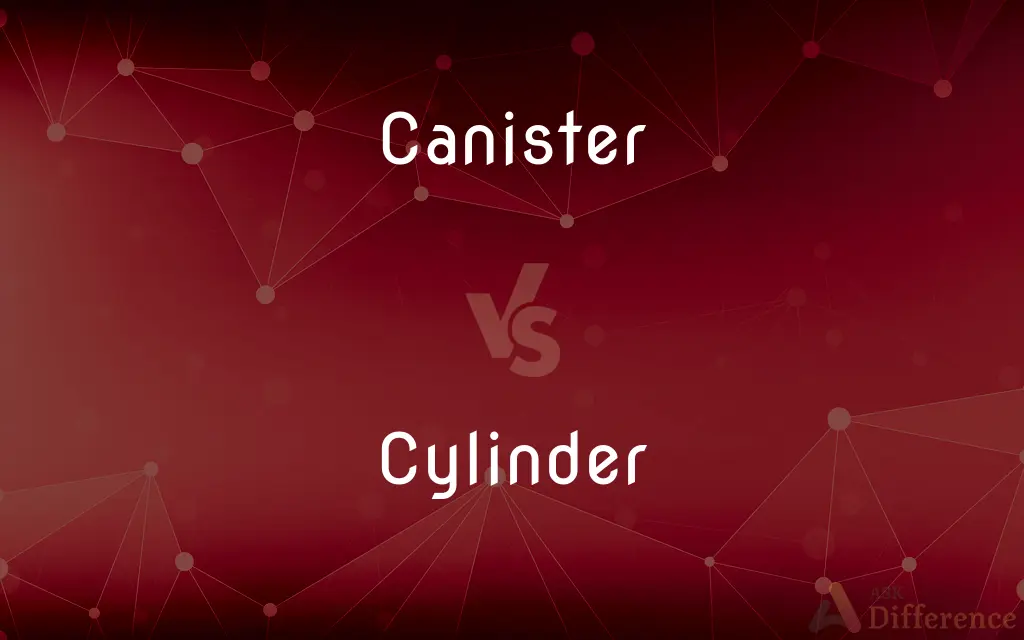Canister vs. Cylinder — What's the Difference?
By Urooj Arif & Fiza Rafique — Updated on April 4, 2024
A canister is a type of container usually with a lid, used for storage, while a cylinder is a geometric shape with circular ends and a curved side.

Difference Between Canister and Cylinder
Table of Contents
ADVERTISEMENT
Key Differences
While a canister is often cylindrical in shape, not all cylinders are canisters. The key distinction lies in the purpose and functionality: canisters are specifically designed for storage, with features like lids to secure their contents, whereas cylinders might not be designed to hold anything at all, serving instead as components in machinery or simply as objects studied in geometry.
The material composition of canisters can vary widely, from metal to plastic to glass, depending on their intended use. They are crafted to be durable and often decorative, especially those used in kitchens. Cylinders, when referring to objects rather than geometric figures, can be made from metal, plastic, or other materials suited to their specific applications, such as withstanding high pressures in the case of gas cylinders.
Understanding the difference between a canister and a cylinder is important for practical reasons, especially in contexts where the shape of an object might be described geometrically (cylinder) or by its intended use (canister). This distinction is particularly relevant in design, manufacturing, and everyday conversation when specificity is required to avoid confusion.
Comparison Chart
Definition
A storage container with a lid.
A geometric shape with circular ends and a curved side.
Primary Use
Storing food, chemicals, or other materials.
Describing shapes or objects in geometry and various practical applications.
ADVERTISEMENT
Shape
Often cylindrical, but can vary.
Strictly a 3D shape with two circular bases and a curved side.
Material
Metal, plastic, glass, etc., depending on use.
Material varies based on the object’s function, not strictly defined.
Features
Airtight lids for preservation.
Does not inherently include features for storage or preservation.
Compare with Definitions
Canister
Decorative and functional.
The ceramic canisters added charm to the pantry.
Cylinder
Versatile object.
The cylinder served as the base for the sculpture.
Canister
Storage solution.
The tea was kept fresh in a sealed canister.
Cylinder
Geometric shape.
A candle is often in the shape of a cylinder.
Canister
Varied materials.
The metal canister was perfect for storing flour.
Cylinder
Storage shape.
The gas cylinder was stored securely outdoors.
Canister
Durable design.
Her kitchen featured glass canisters for dry goods.
Cylinder
Engine component.
The engine’s power is generated in its cylinders.
Canister
Airtight container.
The canister’s airtight lid keeps coffee beans fresh.
Cylinder
Construction element.
Cylindrical columns support the structure.
Canister
A round or cylindrical container used for storing such things as food, chemicals, or rolls of film.
Cylinder
A cylinder (from Greek: κύλινδρος, romanized: kulindros, lit. 'roller', 'tumbler') has traditionally been a three-dimensional solid, one of the most basic of curvilinear geometric shapes. It is the idealized version of a solid physical tin can having lids on top and bottom.
Canister
A box or can of thin metal or plastic used for holding dry foodstuffs or cooking ingredients, such as flour or sugar.
Cylinder
A solid geometrical figure with straight parallel sides and a circular or oval cross section.
Canister
A small plastic container used for storing a roll of film.
Cylinder
A piston chamber in a steam or internal combustion engine.
Canister
A metal container that holds pressurized gas, as one containing tear gas that explodes on impact or one containing oxygen as part of a breathing apparatus.
Cylinder
A cylinder-shaped container holding liquefied gas under pressure.
Canister
A metallic cylinder packed with shot that scatter upon discharge from a cannon, formerly used as an antipersonnel round.
Cylinder
A rotating metal roller in a printing press.
Canister
Such cylinders, or the shot used in such cylinders, considered as a group.
Cylinder
A cylinder seal.
Canister
The part of a gas mask that contains the filter for removing toxic agents from the air.
Cylinder
The surface generated by a straight line intersecting and moving along a closed plane curve, the directrix, while remaining parallel to a fixed straight line that is not on or parallel to the plane of the directrix.
Canister
A cylindrical or rectangular container usually of lightweight metal, plastic, or laminated pasteboard used for holding a dry product (as tea, crackers, flour, matches).
Cylinder
The portion of such a surface bounded by two parallel planes and the regions of the planes bounded by the surface.
Canister
Any of various cylindrical metal receptacles usually with a removable close-fitting top.
Cylinder
A solid bounded by two parallel planes and such a surface, especially such a surface having a circle as its directrix.
Canister
A special short-range antipersonnel projectile consisting of a casing of light metal, loaded with preformed submissiles such as flechettes or steel balls. The casing is designed to open just beyond the muzzle of the weapon, dispersing the submissiles.
Cylinder
A cylindrical container or object.
Canister
A projectile component containing colored or screening smoke or riot control agent composition.
Cylinder
The chamber in which a piston of a reciprocating engine moves.
Canister
A component of canister-type protective masks containing a mechanical filter and chemical filling to filter, neutralize and/or absorb toxic chemical, biological and radiological agents.
Cylinder
The chamber of a pump from which fluid is expelled by a piston.
Canister
Part of a windmill that connects the sails to the windshaft.
Cylinder
The rotating chamber of a revolver that holds the cartridges.
Canister
(transitive) To pack into a canister.
Cylinder
Any of several rotating parts in a printing press, especially one that carries the paper.
Canister
A small basket of rushes, reeds, or willow twigs, etc.
Cylinder
(Archaeology)A cylindrical stone or clay object with an engraved design or inscription.
Canister
A small box or case for holding tea, coffee, etc.
Cylinder
(geometry) A surface created by projecting a closed two-dimensional curve along an axis intersecting the plane of the curve. Category:en:Surfaces
When the two-dimensional curve is a circle, the cylinder is called a circular cylinder. When the axis is perpendicular to the plane of the curve, the cylinder is called a right cylinder. In non-mathematical usage, both right and circular are usually implied.
Canister
A kind of case shot for cannon, in which a number of lead or iron balls in layers are inclosed in a case fitting the gun; - called also canister shot.
Cylinder
(geometry) A solid figure bounded by a cylinder and two parallel planes intersecting the cylinder.
Canister
A metallic cylinder packed with shot and used as ammunition in a firearm
Cylinder
Any object in the form of a circular cylinder.
Canister
Metal container for storing dry foods such as tea or flour
Cylinder
A cylindrical cavity or chamber in a mechanism, such as the counterpart to a piston found in a piston-driven engine.
Cylinder
(automotive) The space in which a piston travels inside a reciprocating engine or pump.
Cylinder
A container in the form of a cylinder with rounded ends for storing pressurized gas; a gas cylinder.
Cylinder
An early form of phonograph recording, made on a wax cylinder.
Cylinder
The part of a revolver that contains chambers for the cartridges.
Cylinder
(computing) The corresponding tracks on a vertical arrangement of disks in a disk drive considered as a unit of data capacity.
Cylinder
(transitive) To calender; to press (paper, etc.) between rollers to make it glossy.
Cylinder
A solid body which may be generated by the rotation of a parallelogram round one its sides; or a body of rollerlike form, of which the longitudinal section is oblong, and the cross section is circular.
Cylinder
Any hollow body of cylindrical form
Cylinder
The revolving square prism carrying the cards in a Jacquard loom.
Cylinder
A cylindrical container for oxygen or compressed air
Cylinder
A solid bounded by a cylindrical surface and two parallel planes (the bases)
Cylinder
A surface generated by rotating a parallel line around a fixed line
Cylinder
A chamber within which piston moves
Common Curiosities
What distinguishes a canister from a cylinder?
A canister is a type of storage container, often with a lid, while a cylinder is a geometric shape or an object resembling this shape.
Can a canister be cylindrical?
Yes, many canisters have a cylindrical shape, but they also feature lids for storage purposes.
What materials are canisters made from?
Canisters can be made from metal, plastic, glass, or other materials, depending on their intended use.
What is a cylinder used for?
As a geometric shape, it’s studied in mathematics; as an object, it can be a part of machinery, like an engine, or used for storage, like a gas cylinder.
Are all cylinders considered canisters?
No, not all cylinders are canisters, as cylinders refer to a shape and not specifically to storage containers.
How do you seal a canister?
Canisters are often designed with airtight lids to keep contents fresh and protected.
Can canisters be used for decoration?
Yes, canisters are often designed to be both functional and decorative, especially in settings like kitchens.
What role do cylinders play in engines?
Cylinders in engines house the pistons and are critical for creating the engine's power through the combustion process.
How are canisters used in the kitchen?
Canisters are used to add charm and beauty in the kitchen.
Is the shape of a cylinder always the same?
Yes, geometrically, a cylinder has a consistent shape with two parallel, circular bases and a curved side.
Share Your Discovery

Previous Comparison
Bath vs. Bathe
Next Comparison
Mowed vs. MownAuthor Spotlight
Written by
Urooj ArifUrooj is a skilled content writer at Ask Difference, known for her exceptional ability to simplify complex topics into engaging and informative content. With a passion for research and a flair for clear, concise writing, she consistently delivers articles that resonate with our diverse audience.
Co-written by
Fiza RafiqueFiza Rafique is a skilled content writer at AskDifference.com, where she meticulously refines and enhances written pieces. Drawing from her vast editorial expertise, Fiza ensures clarity, accuracy, and precision in every article. Passionate about language, she continually seeks to elevate the quality of content for readers worldwide.
















































